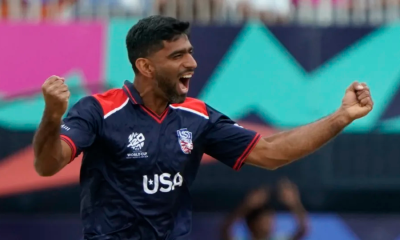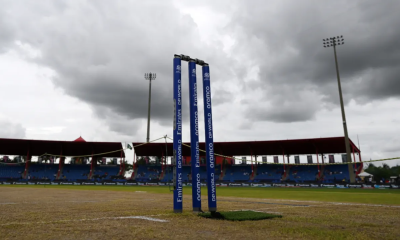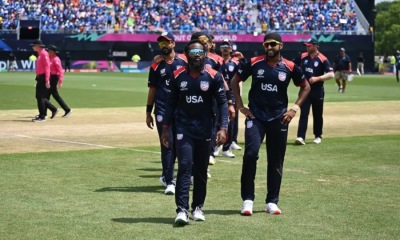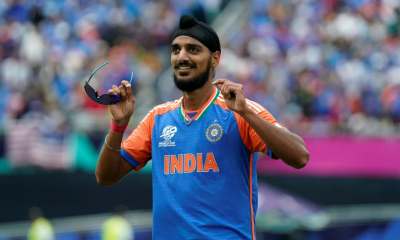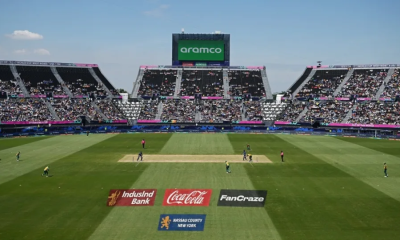Foreign News
Former CIA hacker sentenced to 40 years in prison

A former CIA officer has been sentenced to 40 years in prison for leaking a trove of classified hacking tools to whistle-blowing platform Wikileaks.
Joshua Schulte was also found guilty of possessing child abuse images.
Prosecutors have accused him of leaking the CIA’s “Vault 7” tools, which allow intelligence officers to hack smartphones and use them as listening devices. They said the leak is one of the most “brazen” in US history.
Schulte, 35, shared some 8,761 documents to Wikileaks in 2017, amounting to the largest data breach in the history of the CIA, the US justice department said. He denied the allegations, but was convicted on the various counts at three separate federal trials in New York in 2020, 2022, and 2023.
On Thursday, he was sentenced for charges of espionage, computer hacking, contempt of court, making false statements to the FBI and possession of child abuse images.
“Joshua Schulte betrayed his country by committing some of the most brazen, heinous crimes of espionage in American history,” said US Attorney Damian Williams.
According to evidence shared at the trial, Schulte was employed as a software developer in the Center for Cyber Intelligence, which conducts cyber espionage against terrorist organisations and foreign governments.
Prosecutors said that in 2016 that he transmitted the stolen information to Wikileaks and then lied to FBI agents about his role in the leak.
They said that he was seemingly motivated by anger over a workplace dispute.
Schulte had been struggling to meet deadlines and Assistant US Attorney Michael Lockard said one of his projects was so far behind schedule that he had earned the nickname “Drifting Deadline”.
The prosecutors said he wanted to punish those he perceived to have wronged him and said in “carrying out that revenge, he caused enormous damage to this country’s national security”.
Wikileaks began publishing classified data from the files in 2017.
The leak, prosecutors said, “immediately and profoundly damaged the CIA’s ability to collect foreign intelligence against America’s adversaries; placed CIA personnel, programs, and assets directly at risk; and cost the CIA hundreds of millions of dollars.”
The FBI interviewed Schulte several times after WikiLeaks published the data, where he denied responsibility.
A search of his apartment, prosecutors said, later revealed “tens of thousands of images of child sexual abuse materials”.
They added that after his arrest, Schulte attempted to transmit more information. He smuggled a phone into jail where he attempted to send a reporter information about CIA cyber groups and drafted tweets that included information about CIA cyber tools under the name Jason Bourne, a fictional intelligence operative.
He has been held behind bars since 2018.
(BBC)
Features
Voting for new Pope set to begin with cardinals entering secret conclave

On Wednesday evening, under the domed ceiling of Michelangelo’s Sistine Chapel, 133 cardinals will vote to elect the Catholic Church’s 267th pope.
The day will begin at 10:00 (09:00 BST) with a mass in St Peter’s Basilica. The service, which will be televised, will be presided over by Giovanni Battista Re, the 91-year-old Cardinal Dean who was also the celebrant of Pope Francis’ funeral.
In the early afternoon, mobile signal within the territory of the Vatican will be deactivated to prevent anyone taking part in the conclave from contacting the outside world.
Around 16:15 (15:15 BST), the 133 cardinal electors will gather in the Pauline Chapel and form a procession to the Sistine Chapel.
Once in the Sistine Chapel, one hand resting on a copy of the Gospel, the cardinals will pronounce the prescribed oath of secrecy which precludes them from ever sharing details about how the new Pope was elected.
When the last of the electors has taken the oath, a meditation will be held. Then, the Master of Pontifical Liturgical Celebrations Diego Ravelli will announce “extra omnes” (“everybody out”).
He is one of three ecclesiastical staff allowed to stay in the Sistine Chapel despite not being a cardinal elector, even though they will have to leave the premises during the counting of the votes.
The moment “extra omnes” is pronounced marks the start of the cardinals’ isolation – and the start of the conclave.
The word, which comes from the Latin for “cum clave”, or “locked with key” is slightly misleading, as the cardinals are no longer locked inside; rather, on Tuesday Vatican officials closed the entrances to the Apostolic Palace – which includes the Sistine Chapel- with lead seals which will remain until the end of the proceedings. Swiss guards will also flank all the entrances to the chapel.

Diego Ravelli will distribute ballot papers, and the cardinals will proceed to the first vote soon after.
While nothing forbids the Pope from being elected with the first vote, it has not happened in centuries. Still, that first ballot is very important, says Austen Ivereigh, a Catholic writer and commentator.
“The cardinals who have more than 20 votes will be taken into consideration. In the first ballot the votes will be very scattered and the electors know they have to concentrate on the ones that have numbers,” says Ivereigh.
He adds that every other ballot thereafter will indicate which of the cardinals have the momentum. “It’s almost like a political campaign… but it’s not really a competition; it’s an effort by the body to find consensus.”
If the vote doesn’t yield the two-third majority needed to elect the new pope, the cardinals go back to guesthouse Casa Santa Marta for dinner. It is then, on the sidelines of the voting process, that important conversations among the cardinals take place and consensus begins to coalesce around different names.
According to Italian media, the menu options consist of light dishes which are usually served to guests of the residence, and includes wine – but no spirits. The waiters and kitchen staff are also sworn to secrecy and cannot leave the grounds for the duration of the conclave.
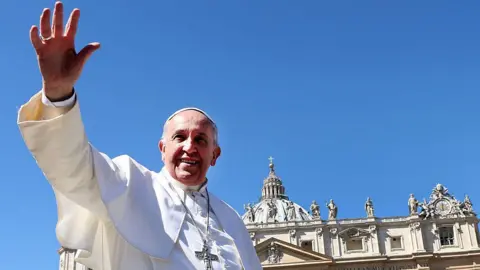
From Thursday morning, cardinals will be taking breakfast between 06:30 (05:30 BST) and 07:30 (06:30 BST) ahead of mass at 08:15 (07:15 BST). Two votes then take place in the morning, followed by lunch and rest. In his memoirs, Pope Francis said that was when he began to receive signals from the other cardinals that serious consensus was beginning to form around him; he was elected during the first afternoon vote. The last two conclaves have all concluded by the end of the second day.
There is no way of knowing at this stage whether this will be a long or a short conclave – but cardinals are aware that dragging the proceedings on could be interpreted as a sign of gaping disagreements.
As they discuss, pray and vote, outside the boarded-up windows of the Sistine Chapel thousands of faithful will be looking up to the chimney to the right of St Peter’s Basilica, waiting for the white plume of smoke to signal that the next pope has been elected.
[BBC]
Foreign News
India launches air strikes on Pakistan and Pakistan-administered Kashmir

The Indian government says it has launched missile strikes on nine sites in Pakistan and Pakistan-administered Kashmir.
Pakistan has confirmed three locations have been hit in what it described as a “cowardly attack”. Foreign Minister Muhammad Ishaq Dar has said eight civilians have died and 35 others have been injured. India has not commented on the toll.
[BBC]
Foreign News
Trump criticised after posting AI image of himself as Pope

US President Donald Trump has attracted criticism from some Catholics after posting an AI-generated image of himself as the Pope.
The picture, which was shared by official White House social media accounts, comes as Catholics mourn the death of Pope Francis, who died on 21 April, and prepare to choose the next pontiff.
The New York State Catholic Conference accused Trump of mocking the faith. The post comes days after he joked to reporters: “I’d like to be Pope.”
Trump is not the first president to be accused of making a mockery of the Catholic faith. Former US President Joe Biden caused outrage a year ago when he made the sign of the cross at a pro-abortion access rally in Tampa, Florida.
Vatican spokesman Matteo Bruni declined to answer questions about Trump’s post during a briefing with journalists on Saturday. The Vatican is preparing to host a conclave to choose Francis’s successor beginning on Wednesday [07].
The image posted by Trump on Friday night features him wearing a white cassock and pointed miter, traditionally worn by a bishop. He wears a large cross around his neck, and has his finger held up, with a solemn facial expression.
The New York State Catholic Conference, which represents bishops in New York, took to X to criticise the picture. “There is nothing clever or funny about this image, Mr President,” the group wrote. “We just buried our beloved Pope Francis and the cardinals are about to enter a solemn conclave to elect a new successor of St Peter. Do not mock us.”
Left-leaning Italian former Prime Minister Matteo Renzi also blasted Trump’s post. “This is an image that offends believers, insults institutions and shows that the leader of the right-wing world enjoys clowning around,” Renzi wrote in Italian on X.
But the White House rejected any suggestion that the Republican president was making fun of the papacy.
“President Trump flew to Italy to pay his respects to Pope Francis and attend his funeral, and he has been a staunch champion for Catholics and religious liberty,” said press secretary Karoline Leavitt.
[BBC]
-

 News6 days ago
News6 days agoRanil’s Chief Security Officer transferred to KKS
-

 Opinion4 days ago
Opinion4 days agoRemembering Dr. Samuel Mathew: A Heart that Healed Countless Lives
-

 Business2 days ago
Business2 days agoAitken Spence Travels continues its leadership as the only Travelife-Certified DMC in Sri Lanka
-

 Features7 days ago
Features7 days agoThe Broken Promise of the Lankan Cinema: Asoka & Swarna’s Thrilling-Melodrama – Part IV
-

 News7 days ago
News7 days agoRadisson Blu Hotel, Galadari Colombo appoints Marko Janssen as General Manager
-

 Business2 days ago
Business2 days agoLinearSix and InsureMO® expand partnership
-

 Business6 days ago
Business6 days agoCCPI in April 2025 signals a further easing of deflationary conditions
-

 Features7 days ago
Features7 days agoA piece of home at Sri Lankan Musical Night in Dubai



